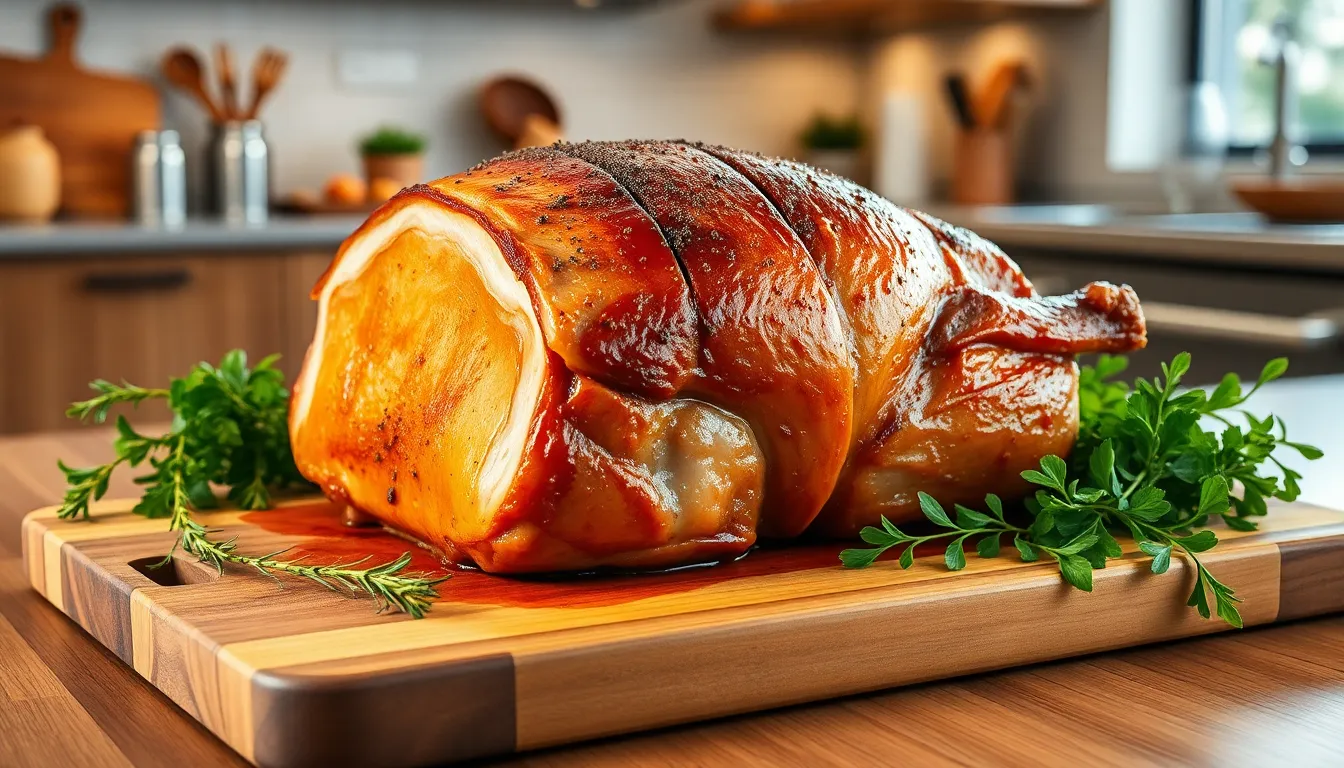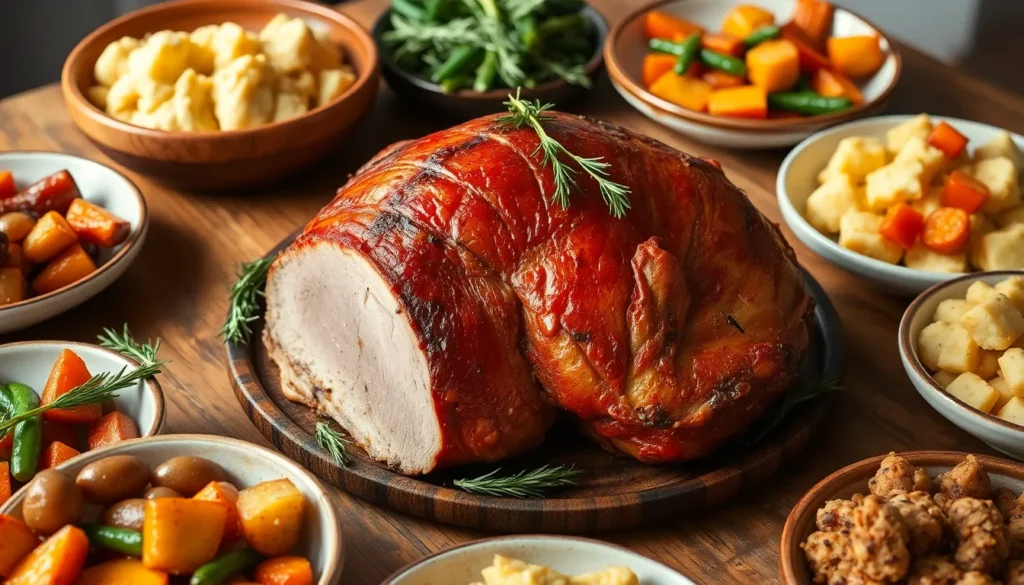Table of Contents
ToggleBaking a pork roast might sound like a culinary challenge, but it’s actually as easy as pie—well, easier if you don’t burn the pie. Picture this: a succulent roast, golden brown on the outside and juicy on the inside, filling your kitchen with mouthwatering aromas. Who wouldn’t want to impress family and friends with a dish that looks like it came straight from a gourmet restaurant?
Preparing the Pork Roast
Preparing the pork roast involves essential steps for achieving optimal flavor and tenderness. A careful selection of cut and thoughtful seasoning elevates the dish.
Choosing the Right Cut
Selecting the right cut of pork is critical. Options include pork loin, shoulder, or rib roast. Each cut offers unique flavors and textures. Pork loin provides a lean, tender option, while shoulder delivers rich, savory meat ideal for slow roasting. Rib roast combines flavor with juiciness, enhancing the final result. Opt for a cut with some fat marbling to keep the roast moist during baking.
Important Seasonings and Marinades
Seasoning helps develop robust flavors in the roast. Popular ingredients include garlic, rosemary, thyme, and paprika. A marinade featuring olive oil, vinegar, and honey can tenderize the meat while adding depth. Allowing the pork to marinate for at least four hours enhances flavor absorption. When seasoning, don’t forget to salt the meat to enhance its natural taste. Consider using a spice rub to create a flavorful crust that complements the roast.
Baking Techniques

Baking a pork roast involves attention to detail and specific techniques. Mastering these methods ensures a flavorful and tender outcome.
Preheating the Oven
Preheating the oven sets the stage for even cooking. Aim for a temperature of 350°F (175°C) to create a consistent heat environment. Allowing the oven to fully preheat prevents cold spots during baking, which can lead to uneven cooking. This step ensures the roast begins cooking immediately upon placement in the oven, promoting better moisture retention and flavor.
Cooking Methods
Utilizing various cooking methods elevates the pork roast. Roasting offers a method where dry heat circulates around the meat, resulting in a perfect crust. Alternatively, braising combines moist heat with roasting, using liquids such as broth or wine to enhance tenderness and flavor. Slow cooking requires lower temperatures over an extended period, allowing the connective tissues to break down thoroughly. Each cooking technique contributes to the overall quality and taste, transforming a simple cut into a gourmet dish.
Checking for Doneness
Ensuring perfect doneness for a pork roast requires precision. Using a meat thermometer serves as the most reliable method for determining readiness.
Using a Meat Thermometer
Insert a meat thermometer into the thickest part of the roast, avoiding exposure to bone. A temperature of 145°F (63°C) signifies that the pork is safe to consume. Remove it from the oven when the thermometer reaches this temperature, allowing for a rest period. Resting permits the juices to redistribute, enhancing flavor and tenderness. Always clean the thermometer after each use to maintain hygiene.
Understanding Internal Temperatures
Understanding internal temperatures is crucial for achieving desired results. The safe minimum internal temperature for pork is 145°F (63°C), which allows for a slight pink hue in the center. However, a target of 160°F (71°C) ensures a fully cooked roast with no pinkness. Ground pork requires cooking to a minimum of 160°F (71°C) for safety. Keeping these guidelines in mind allows for a perfectly baked pork roast every time.
Serving Suggestions
Baking a pork roast offers many opportunities for delicious pairings and attractive presentations. Enhance the dining experience with thoughtful side dishes and elegant plating.
Side Dishes that Pair Well
Consider serving roasted vegetables alongside the pork roast. Carrots, potatoes, and Brussels sprouts provide complementary flavors and textures. Garlic mashed potatoes create a creamy counterpoint, while sautéed green beans add a fresh crunch. Choose a light salad, such as arugula with lemon vinaigrette, to balance the richness of the pork. Applesauce serves as a classic accompaniment, adding a touch of sweetness. Include a grain-based side like wild rice or quinoa for substance and variety. Each dish works in harmony, making the meal both satisfying and visually appealing.
Presentation Tips
Focus on an attractive presentation to elevate the pork roast. Slice the roast into even pieces, allowing the juicy interior to shine. Arrange the slices on a wooden or ceramic platter, and garnish with fresh herbs like rosemary or parsley for a pop of color. Incorporate seasonal fruits, such as apple slices or pomegranate seeds, to enhance the visual appeal. Serve side dishes in separate bowls to create a vibrant display of colors and textures. Use warm dishes to keep everything at an ideal serving temperature. A thoughtful presentation captures attention and invites guests to enjoy the meal.
Baking a pork roast is an accessible way to create a memorable meal that impresses guests and delights the palate. With the right cut of meat and thoughtful seasoning it transforms into a centerpiece that’s both flavorful and visually stunning.
Mastering the baking techniques ensures that the roast remains juicy and tender while achieving that perfect crust. By paying attention to cooking times and temperatures one can achieve a delicious result every time.
Pairing the roast with complementary side dishes not only enhances the meal but also elevates the dining experience. With these tips in hand anyone can confidently bake a pork roast that rivals gourmet offerings.







